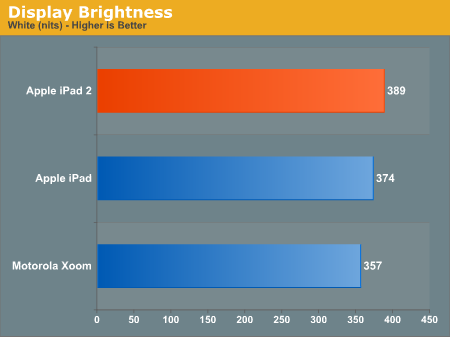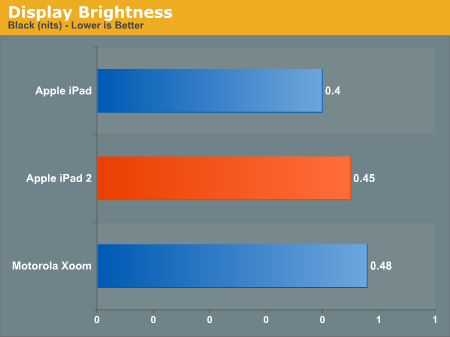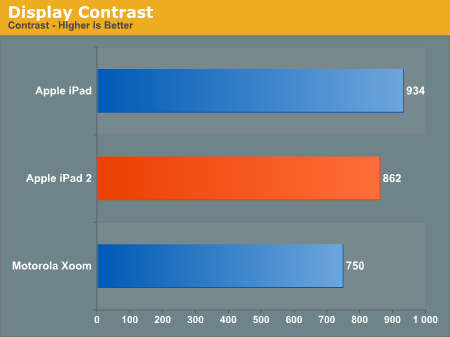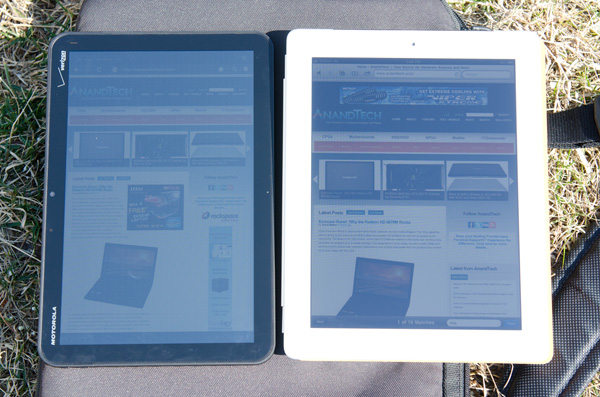The Apple iPad 2 Review
by Brian Klug, Anand Lal Shimpi & Vivek Gowri on March 19, 2011 8:01 PM ESTDisplay
The iPad 2 continues to use what boils down to the same 9.7 inch 1024x768 (XGA) LCD as the iPad 1. It isn’t the 300 or close PPI display that many speculated would launch with the iPad 2. Instead, for the most part, it’s identical to the 132 PPI panel which shipped in the first iPad.
Side by side the two have very similar brightness, black level, and contrast. That said, we’ve noticed some differences in the numbers between the four iPad 2s spread among us. Two are 16 GB WiFi models, one is an AT&T WiFi - 3G, and another is Verizon WiFi - 3G. Each have slightly different brightness and black levels, and correspondingly different contrast as well.
| Display Quality Comparison | |||||
| White Level | Black Level | Contrast Ratio | |||
| Apple iPad 2 #1 (AT&T 3G) | 406 nits | 0.42 nits | 966:1 | ||
| Apple iPad 2 #2 (VZW 3G) | 409 nits | 0.49 nits | 842:1 | ||
| Apple iPad 2 #3 (WiFi) | 352 nits | 0.45 nits | 778:1 | ||
| Apple iPad 2 #4 (WiFi) | 354 nits | 0.41 nits | 859:1 | ||
After looking at the numbers we’ve collected, there seems to be a pretty obvious trend emerging. The WiFi iPads seem to have a brightness closer to 350 nits, whereas the 3G models have brightness levels at 400 nits. It seems entirely possible that there are either multiple suppliers for these panels, or different batches with differing performance characteristics between the WiFi and 3G manufacturing lines.



We measured white point on the iPad 2 with an X-Rite i1Pro and found that (at least my AT&T 3G model) it was right at 6604K, very close to D65 and good performance. Conversely, the iPad 1 WiFi on hand measured around 6908K which is admittedly still acceptable, but not quite as good. In reality, there will probably be a large amount of drift in color temperature across different panel suppliers and batches, just like we saw with the Verizon iPhone 4’s noticeably blue display.
Indoor viewing angles on the iPad 2’s IPS display are still excellent. Uniformity is also good, with one caveat.
There’s been a lot of talk about backlight bleeding on the iPad 2. Initially, I didn’t notice any backlight bleed on my iPad 2, however I now notice a small blotch where backlight bleeds in the bottom right corner. Pressing on the glass surface, I can change the intensity of this backlight bleed, which would imply that the bleed is due to stresses in the glass and TFT like you’d see if you were to press on a panel. It’s not bad at all, especially compared to some of the worst-affected examples I’ve seen in forums online, but hopefully this gets worked out with better manufacturing. Oddly enough, side by side with the iPad 2 the iPad 1 also shows some noticeable light bleed.
Outdoor glare and viewing angles are essentially unchanged. Subjectively the iPad 2 seems a tiny bit better, perhaps thanks to the slightly thinner glass and adhesion process, but it’s still hard to read anything outside in direct sunlight.
Compared to the Xoom, the iPad 2 is more usable outdoors:



















189 Comments
View All Comments
TareX - Sunday, March 20, 2011 - link
Irrelevant, but is Anandtech gonna do an Atrix review?name99 - Sunday, March 20, 2011 - link
"The Digital AV adapter is a bit clunky and I believe the future of this is clearly in some form of wireless transmission, but for now it plugs directly into the dock connector. "You mean the wireless transmission that ALREADY EXISTS called AirPlay?
Apple HAVE a solution to your hatred of wires. You seem to be upset that they don't have a solution that somehow magically transports video from iPad to your (HDMI and nothing else) TV using some non-existent wireless standard that isn't actually built into your TV.
It's fine to be frustrated at some of the idiocies in tech, but it's truly silly to complain about this one. Apple provides this cable for one, and only one, group of users --- people who actually NEED that physical wire.
BlendMe - Sunday, March 20, 2011 - link
AirPlay doesn't mirror tha iPads screen, it only allows you to stream content. For now. And for AirPlay you need an Apple TV or another AirPlay enabled device. The HDMI adapter allows you to hook it up to almost any recent TV, monitor or beamer.ananduser - Sunday, March 20, 2011 - link
In fact there is a standard already built in in most modern(emphasis on modern) TVs. It is called DLNA. Unfortunately Apple decided that coercing you into using their ecosystem ONLY is the way to go. Personally I find Apple's modus operandi of not giving 2 sh*ts about other 3rd party solutions one of the "idiocies in tech" as you well put it.Regardless, the iPad2(or 1) is a cool gadget(emphasis on gadget) nonetheless. Combined with leading parental controls as:no flash(as a porn enabler), no porn(appstore policy), no bloody/gory games(appstore policy) and a damn spartan simple and fast GUI makes it a great basic computing device for the naive crowd(parents, grandparents etc.). IMO it really shines for children as their 1st computing platform.
That it is also a frequent choice for the tech literate few, good on them... it still is best suited, IMO, for those of the above.
name99 - Sunday, March 20, 2011 - link
Can both of you not read?I was referring to, as I quoted, "The Digital AV adapter is a bit clunky and I believe the future of this is clearly in some form of wireless transmission, but for now it plugs directly into the dock connector. "
How do either of your comments have any relevance to that?
If you want Wifi, you need something that accepts a Wifi signal. Your TV doesn't have Wifi built in, so, yeah, you need some other box.
And DLNA? Really? You want to go there? Go explore the DLNA web pages (http://www.dlna.org/products is a good start) and tell me this pile of turds is EVER going to be relevant to the real world. For god's sake, man, get in touch with the real world. Compare that web page and everything it implies about compatibility nightmares and technobabble with the Apple TV web page.
Anand Lal Shimpi - Monday, March 21, 2011 - link
AirPlay is really for specific content at this point. I'm referring to the future of video out on tablets in general. And I didn't mention it as a knock against the iPad today, just a heads up that in some future version of the iPad you won't need a physical adapter (at least not on your tablet). When you have full wireless display mirroring then you can start introducing more interesting usage models - e.g. tablet as a desktop replacement, tablet as a game console, etc... You can do these things without wireless display but they are definitely enhanced by it being there.Take care,
Anand
Ushio01 - Sunday, March 20, 2011 - link
When ifixit did there teardown of the first ipad it was shown that apart from the battery and the antennas all the other components were kept up the top so why can't a tablet simply be a dock you slot a smartphone in that supplies a larger screen and additional battery's?That to me is a far more appealing device than current tablets.
kmmatney - Monday, March 21, 2011 - link
makes sense to me. I can't see Apple doing this, but maybe on of the Android makers can come up with something along these lines. I'd love to be able to pop my phone into the back of a tablet and use the bigger screen. I'd just keep it near the couch.zmatt - Sunday, March 20, 2011 - link
I still hold that the entire market segment (not just the iPad) is a solution looking for a problem. The idea seems cool but in reality nobody was asking for the tablet. And after using them I still can't see what the attractiveness is other than people buying them cause they are "cool". I take calls and get mobile updates on my Galaxy S, which is more than competent enough for light work such as taking down notes or answering emails on the go. Any real work I do with a computer. I'm sorry but you can't make up for the lack of performance and a real keyboard if you are talking about getting work done. The iPad may be nice for mobile entertainment, but if i already have an mp3 player and a laptop what can it do that they can't? For tablets to be viable productivity devices and not just toys i think they would basically have to evolve into laptops. So again i ask, what's the point?cucurigu - Sunday, March 20, 2011 - link
Thanks a lot for your review, Anand, Brian and Vivek - I was waiting for your opinion on the iPad 2 as it was a gadget most appealing but, as you said, very polarizing for the reviewers.There is something I didn't really understand, even after rereading the Xoom review - both you (Anand and Brian) said the first iPad wasn't your cup of tea in the long run and chances are the new one won't change this (but you're giving it another go). The general impression (one which I also got while looking at the tablet segment) is characterized by their unclear niche - where do they really fit ?
If I understand correctly the first tablet (ipad) didn't integrate with your workflow and the reasons seem to apply to all tablets, however, this sentiment doesn't come off so clearly from the Xoom article - so I wondered : did you have the impression the Android OS was more adequate to your usage patterns ? Meaning, if the Xoom and iPad 2 where left on your desk, which one would you choose to take with you, and for which purpose ?
Once again, thanks and best regards !